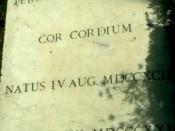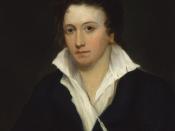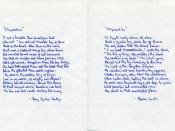On the surface, Percy Bysshe Shelley's "Ozymandias" is Shelley's representation of the posthumous conception of the Egyptian Pharoh named Ramses II (which in Greek translates into Ozymandias). More importantly however, "Ozymandias" comments on the temporal nature of the things humans strive most for. Regardless of what he thought, Ozymandias' empire eventually ceased to exist. Even a statue he has made to reinforce the possibility of his immortality shatters. This sculpture, a piece of art, is able to remain long after Ozymandias' 'greatness' has subsided. This statue, however, will eventually expire too, and all that will remain, that has always remained, is the sand of the desert.
Shelley begins by describing a shattered stone statue with only the legs and head remaining partially erect in the desert. The face of this statue is proud and arrogant, "Half sunk, a shattered visage lies, whose frown, And wrinkled lip, and sneer of cold command, Tell that its sculptor well those passions read"(4-6).
On the pedestal of the statue, there are these words, " 'My name is Ozymandias, king of kings: Look on my works, ye Mighty, and despair!'"(10-11). The reader is informed that, "Nothing beside remains" (12) of Ozymandias or his works. The surrounding desert is solitary as "The lone and level sands stretch far away" (14).
Although he has a statue made as a reminder of the power of his existence, Ozymandias is forgotten as all other things eventually are. The statue, which certainly represents Ozymandias as a fallen monument, also is the only remnant of his 'great' empire. It is ironic that something created to glorify his being can also elicit his desecration. Shelley also comments here on art's ability to outlast an empire. In true romantic style, it is suggested that the sculptor, who surely enjoyed less power,



Good Job
This was very succinct. It offers multiple examples (which i think could have been more flowing). Perhaps if the 3 paragraph style was ditched for a 2 paragraph'er? hmm. But it was very good, and it offers lots of good ideas.
3 out of 3 people found this comment useful.